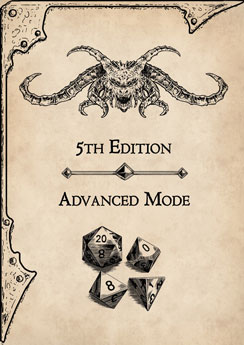Medium beast (animal), unaligned
Armor Class 13 (Natural Armor)
Hit Points 11 (2d8+2)
Speed 40 ft.
Proficiency Bonus +2
Proficiency Bonus +2 (5th Edition Advanced Mode)
| STR | DEX | CON | INT | WIS | CHA |
|---|---|---|---|---|---|
| 12 (+1) | 15 (+2) | 12 (+1) | 3 (-4) | 12 (+1) | 6 (-2) |
Skills Perception +3, Stealth +4
Senses passive Perception 13
Challenge 1/4 (50 XP)
Keen Hearing and Smell. The wolf has advantage on Wisdom (Perception) checks that rely on hearing or smell.
Pack Tactics. The wolf has advantage on an attack roll against a creature if at least one of the wolf’s allies is within 5 ft. of the creature and the ally isn’t incapacitated.
ACTIONS
- Bite. Melee Weapon Attack: +4 to hit, reach 5 ft., one target. Hit: (2d4 + 2) piercing damage. If the target is a creature, it must succeed on a DC 11 Strength saving throw or be knocked prone.
- Bite (suggested). Melee Weapon Attack: +4 to hit, reach 5 ft., one target. Hit: (2d4 + 2) piercing damage. If the target is a Medium or smaller creature, it must succeed on a DC 11 Strength saving throw or be knocked prone
5th Edition Advanced Mode
Limiting the power of a character and making the overall difficulty of the game harder, does not reduce the creativity, indeed it does quite the opposite.
The Game Master has the option to use any and all of the instances proposed in this guide, or just some of them according to their preference.
It is the lack of something that move and motivate characters, not the abundance of it
DESCRIPTION
A wolf is a large, wild canine that resembles a dog, but with a more muscular and leaner body, longer legs, and sharper teeth. Wolves have thick fur coats that vary in color from gray to brown to black, depending on their environment. Wolves have keen senses of smell and hearing, which they use to hunt and communicate with their pack. Wolves are intelligent and social animals, forming strong bonds with their mates and offspring.
COMBAT
Wolves are fierce and cunning predators, using their speed, agility, and teamwork to take down their prey. Wolves prefer to hunt in packs, surrounding and harassing their target until they find an opening to strike. Wolves have a powerful bite that can pierce through flesh and bone, and they often try to knock their prey prone to make them more vulnerable. Wolves are also adept at stealth, using their natural camouflage and silent movement to ambush unsuspecting foes.
HABITAT / SOCIETY
Wolves can be found in a wide range of habitats, from forests and tundras to mountains and deserts. They are adaptable and resilient creatures, able to survive in harsh conditions and scarce resources. Wolves live in hierarchical groups called packs, which usually consist of a breeding pair (the alpha male and female), their offspring, and a few other related or unrelated wolves. The pack cooperates in hunting, raising the young, defending the territory, and maintaining social order. Wolves communicate with each other through body language, facial expressions, vocalizations, and scent marking.
ECOLOGY
Wolves play an important role in the ecology of their habitats, as they help regulate the populations of their prey species and prevent overgrazing or disease outbreaks. Wolves also provide food for other scavengers, such as ravens, vultures, or hyenas. Wolves have few natural enemies, apart from other predators that may compete with them for food or territory, such as bears, lions, or dragons. Wolves are often hunted by humans, who view them as pests, threats, or trophies. Some humans also admire wolves for their strength, loyalty, and beauty, and may seek to befriend or tame them.
